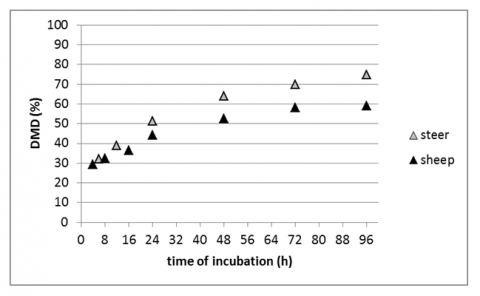Enset leaves are widely fed to ruminants in Ethiopia, particularly during the dry season. Based on the chemical composition and in vivo studies presented below, enset leaves appear to be a valuable forage with a good protein and mineral content. It can be used as a supplement for diets containing low quality roughages (e.g. straw, mature hay or pasture). An energy supplement is advisable.
Note: The author thanks the Swedish University of Agricultural Sciences Library for providing freely some useful documents.
Palatability
No palatability issues have been reported with enset leaves. However, some farmers in Ethiopian enset-livestock systems treat enset leaves with a mineral lick (bojii) to increase palatability (Desta et al., 2004).
Digestibility and degradability
Reported in vitro OM digestibility of enset leaves ranges from 56 to 75%. The reason for the large difference between studies is unclear (Mohammed et al., 2013; Nurfeta et al., 2012). In one study, in vivo DM and OM digestibilities in sheep were 59%, and the in vitro protein digestibility was 64% (Nurfeta et al., 2009a). Furthermore, in sacco DM disappearance was lower in sheep than in steers (about 60% vs. 75% after 48h respectively), as shown in the table below (Nurfeta et al., 2008a).

Cattle
The treatment of enset leaves with 2% urea solution had no effect on their DM intake (76 g/kg W0.75) in Zebu cows (Fekadu et al., 1997).
Sheep
When offered alone to sheep at maintenance level, DM intake of enset leaves was 42.6 g/kg W0.75, and the nitrogen balance was positive with 6.1 g of nitrogen/d (Nurfeta et al., 2009b). Increasing levels of enset leaves (215, 417, 514 g DM/d) offered to sheep (20 kg BW), fed ad libitum wheat straw, reduced intake of straw, either untreated or treated with urea-CaO. At the lower level of enset leaves, sheep consumed almost all the leaves but at the two higher levels the DM intake of leaves reached a plateau with 283 and 312 g DM/d with treated and untreated straw, respectively. There was no weight gain with the lowest level of supplement and a small weight gain at the two higher levels: 14.8 and 24.3 g/d, respectively. Results tended to be better with untreated than with treated wheat straw, with an average weight gain of 14.9 and 9.7 g/d respectively (Nurfeta et al., 2009a).
Goats
When enset leaves were offered at three levels (74, 148 or 220 g DM/d) as a supplement to dairy goats grazing natural pasture, the goats consumed all the offered leaves. Milk yield and fat content increased up to the first supplement level compared to the control diet (grazing only): 0.59 vs. 0.37 L/d and 54 vs. 42 g/L, respectively. Milk protein significantly increased with the two higher levels of supplement. However, with the highest level the weight gain of the does was lower (94 g/d). The daily weight gain of kids from the supplemented does was improved (90-99 vs. 79 g/d) at all levels of enset leaves (Nurfeta et al., 2012).

